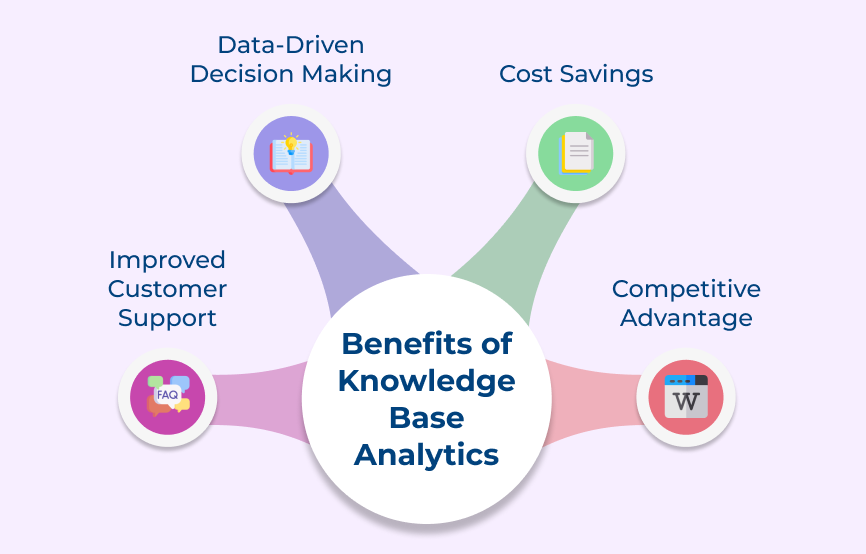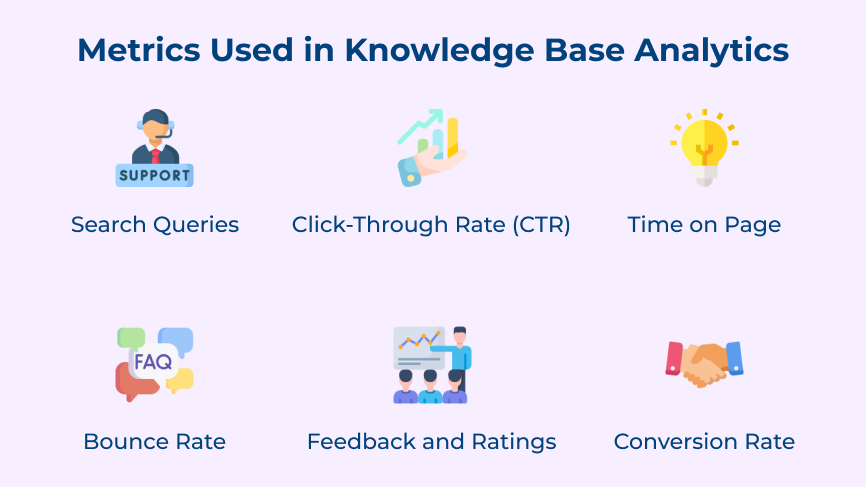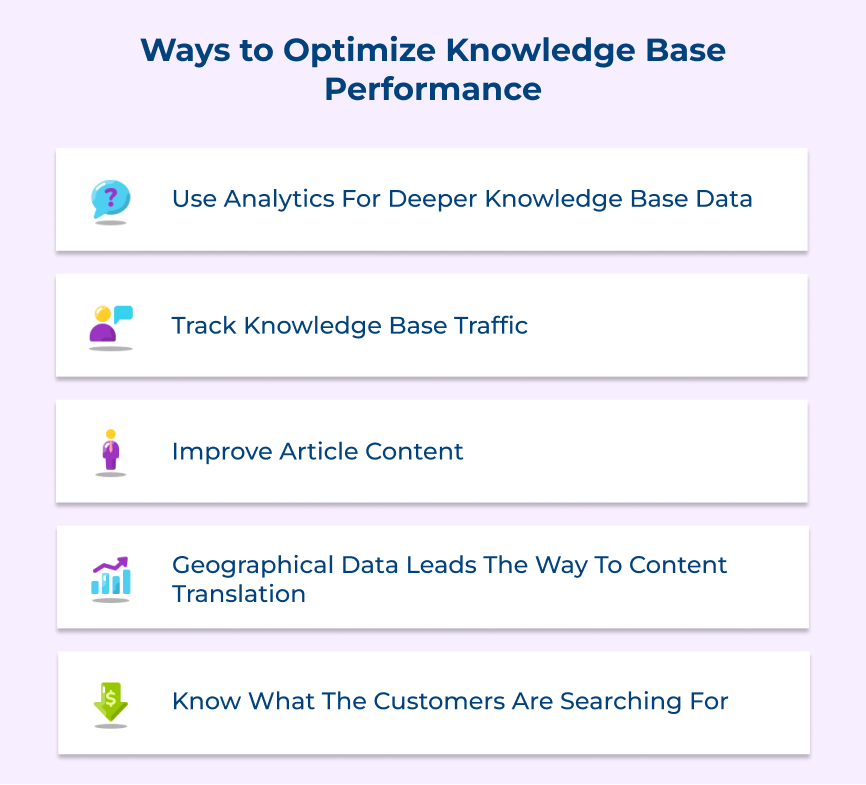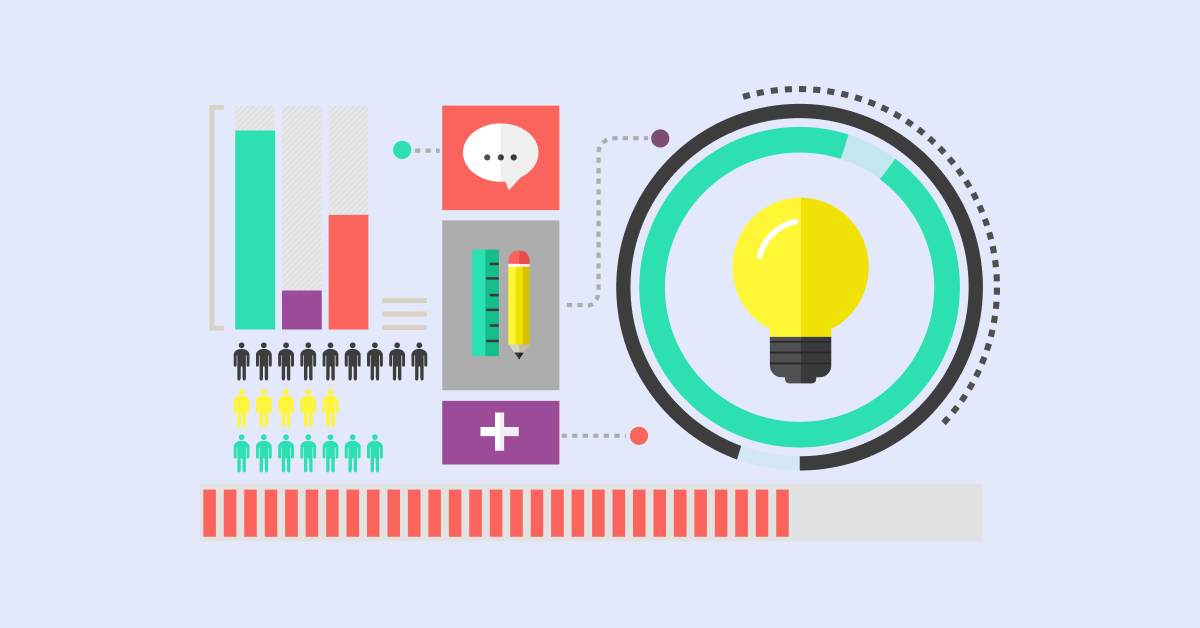Knowledge Base Analytics: Insights to Boost Self-Service
Knowledge base analytics tracks how users interact with the self-service content. It reveals what articles are most popular, what search terms are used and areas where content is lacking.

Knowledge base analytics tracks how users interact with the self-service content. It reveals what articles are most popular, what search terms are used and areas where content is lacking.

The ability to analyze and utilize knowledge effectively is crucial for success. Knowledge base analytics is a powerful tool for organizations. It can help them gain valuable insights from their knowledge base to make better decisions.
Companies are constantly seeking ways to optimize their operations and stay ahead of the competition. Statistics show a 404% return on investment (ROI) over five years of using knowledge management systems.
Organizations can uncover hidden patterns and correlations within their data that may not be apparent through traditional methods. Let us understand how harnessing the power of analytics can help them make more informed decisions and drive innovation.
Knowledge base analytics refers to the systematic process of examining how users interact with your organization’s knowledge repository. Think of it as putting a magnifying glass over every search query, article view and user journey through your help documentation. The data-driven approach reveals patterns in information consumption and identifies gaps where users struggle to find answers.
Analytics tools track user behavior across your knowledge base through metrics like search queries and page views. The system captures data on what people look for and where they get stuck. Advanced platforms use machine learning to identify content gaps and suggest improvements. It creates a feedback loop that continuously optimizes your knowledge repository based on real user needs.
Key objectives:
Check out the key advantages of implementing knowledge base analytics in your company and how it can drive sustainable success.

Companies can improve customer understanding through knowledge base analytics, identifying search patterns and common issues. The analytics allows for the creation of more targeted and helpful support resources. It leads to improved customer satisfaction and reduced support tickets.
Knowledge base analytics provides valuable insights into customer behavior, preferences and trends. The data can help make decisions about product, marketing and engagement. It leads to more successful and profitable outcomes for the company.
Analyzing customer behavior can aid companies in pinpointing cost-saving and operational efficiency opportunities. Optimizing processes based on analytics data can reduce waste, increase efficiency and save money.
Companies that leverage data and analytics have a significant advantage over those that do not. Companies can stay ahead of the curve, understand their customers better and make smarter decisions by implementing KB Analytics.
Below are the critical metrics that can help you assess the strengths and weaknesses of your knowledge base, enabling you to enhance its user experience.

Search queries are an essential metric used in knowledge base analytics to understand what users are searching for on a website. The metric shows keywords users use in the search bar to find information. Analyzing search queries can help identify popular topics and user behavior patterns to improve their knowledge base content.
The metric helps businesses to tailor their content to meet user needs, improve search functionality and increase satisfaction. The metric measures how often a search term is entered by users in a set period.
Let’s assume a software company notices a high volume of search queries related to troubleshooting a specific feature.
Best practices:
Click-through Rate (CTR) is a crucial metric used in Knowledge Base Analytics. It helps to measure the effectiveness of a particular article in generating engagement. CTR is the proportion of users who click on a link compared to the total users who view the content.
CTR helps organizations understand if their content is resonating with their audience and driving action. A higher CTR indicates that users are finding the content relevant. A low CTR may suggest that the content needs improvement. Calculate CTR by dividing total clicks by total impressions, then multiply by 100 for a percentage. Let’s consider if an article receives 100 views and 10 clicks, the CTR would be 10%.
Best practices:
“Time on Page” is a crucial metric used in Knowledge Base Analytics to measure how long users spend on a specific page of a website. The metric provides valuable insights into user engagement and interest in the content. The longer the time spent on a page, the more likely it is that the user found the information helpful.
Calculating “Time on Page” is straightforward. The difference is between user arrival and navigation away from a page. Let’s assume if a user arrives on a page at 9:00 AM and leaves at 9:15 AM, the time on a page would be 15 minutes. It is important to consider “Time on Page” to understand which is resonating with users and which may need improvement.
Best practices:
Bounce rate is a key metric used in knowledge base analytics. Measuring the percentage of visitors who leave a page without further interaction is helpful. It helps businesses understand how engaging and relevant their content is to their audience.

A high bounce rate can indicate that the content may not be meeting the needs of the users. It leads to a potential drop in conversions or sales. The bounce rate is determined by dividing single-page visits by total page entries. Let’s consider that if a knowledge base article receives 100 visits and 40 visitors leave without interacting further, the bounce rate would be 40%.
Best practices:
Feedback and ratings are important metrics used in knowledge base analytics. It helps to measure the effectiveness of the information provided in a knowledge base. The metrics offer insights into user needs and highlight areas for content improvement. It can include whether the content was helpful, accurate and easy to understand.
The average rating score can be determined based on the ratings given by users. Similarly, feedback can be categorized to identify common issues. Let’s assume that a knowledge base article receives a high rating and positive feedback. It indicates that the information is valuable and well-received by users. Low ratings and negative feedback could signal that the content needs to be updated.
Best practices:
Conversion Rate is a key metric used in KB Analytics. It helps to measure the effectiveness of the content in converting visitors into customers. The insights show content performance and its impact on audience actions.
Calculating the Conversion Rate is simple: the ratio of desired actions to total visitors to the knowledge base, multiplied by 100, gives the percentage. Let’s consider that a business had 100 visitors to the knowledge base and 10 of them signed up for a trial of the product. The conversion rate would be 10%.
Best practices:
Below are the five strategies to harness analytics effectively and optimize your knowledge base performance.

Analytics can provide valuable insights into how users are interacting with the knowledge base. Analyzing data such as page views, session and bounce rates can help identify patterns. It can help to make informed decisions on how to improve the knowledge base.
Monitoring traffic can help to understand which articles are the most popular and which ones are not getting enough attention. Tracking traffic can help identify gaps in the content and prioritize updates or additions to improve performance.
Analytics can help to identify articles that are not performing well and may need to be revised or optimized. Analyzing metrics such as read time and exit rates can pinpoint areas where content can be improved. It helps to better meet the needs of the customers.
Analyzing geographical data reveals knowledge reach and expansion opportunities in different regions. Understanding the geographic distribution of the audience can help tailor content to better meet the needs of specific regions.
Analytics can reveal valuable insights by showing what customers search for in the knowledge base. Analyzing search queries can help gain a deeper understanding of the information the customers are looking for. It ensures that the knowledge base is optimized to meet their needs.
Utilizing knowledge base analytics can provide valuable insights and improve efficiency in various aspects of the business. Analyzing data on customer behavior, trends and content performance can help make informed decisions. It helps to enhance user experience, optimize content and drive success.
KB analytics will allow you to measure the impact of the knowledge base, identify areas for improvement and track progress. Keeping a check on the analytics can help to stay competitive and continuously improve self-service offerings.
Knowledge base data refers to a centralized repository of information that is organized, updated and easily accessible for users. It typically includes articles, FAQs and other resources to help users find answers to their questions. Knowledge base data is essential for businesses to provide self-service support and improve customer satisfaction.
Knowledge bases can be categorized into two main types: internal and external. Companies create knowledge bases to provide employees with information on offerings. External knowledge bases are accessible to customers and clients. It provides valuable resources and information to help them with their inquiries.
There are a variety of tools available to track knowledge base analytics, including Google Analytics, Zendesk Explore and Helpjuice. The tools can provide detailed insights into user behavior. It can help to track key metrics to improve the performance of the knowledge base.
A knowledge-based skill is a skill that requires specific information, facts, or concepts to be applied to complete a task. The skills are usually acquired through education or experience and are essential for success. Examples of knowledge-based skills include programming languages, medical terminology and marketing strategies
Analyzing data from KB analytics can help identify common pain points and areas of confusion that users are most interested in. The information can be used to optimize content, improve navigation and enhance the user experience. Addressing issues and providing relevant information can increase user satisfaction.

Market better, sell faster and support smarter with Veemo’s Conversation Customer Engagement suite of products.
Unify all your customer data in one platform to deliver contextual responses. Get a 360 degree view of the customer lifecycle without switching tools.
Connect with the tools you love to reduce manual activities and sync your business workflows for a seamless experience.
 https://veemo.io/wp-content/uploads/2024/12/customer-service-response-time.png
1256
2400
Webvision Solution
https://veemo.io/wp-content/uploads/2024/11/veemo.svg
Webvision Solution2025-10-17 10:51:142025-10-17 10:51:149 Effective Tips to Reduce Customer Service Response Time
https://veemo.io/wp-content/uploads/2024/12/customer-service-response-time.png
1256
2400
Webvision Solution
https://veemo.io/wp-content/uploads/2024/11/veemo.svg
Webvision Solution2025-10-17 10:51:142025-10-17 10:51:149 Effective Tips to Reduce Customer Service Response Time https://veemo.io/wp-content/uploads/2024/10/How-to-Create-Knowledge-Base.png
1257
2400
Vikas Sachan
https://veemo.io/wp-content/uploads/2024/11/veemo.svg
Vikas Sachan2024-10-21 12:24:342025-11-03 07:13:21How to Create a Knowledge Base in 9 Easy Steps: The Ultimate Guide
https://veemo.io/wp-content/uploads/2024/10/How-to-Create-Knowledge-Base.png
1257
2400
Vikas Sachan
https://veemo.io/wp-content/uploads/2024/11/veemo.svg
Vikas Sachan2024-10-21 12:24:342025-11-03 07:13:21How to Create a Knowledge Base in 9 Easy Steps: The Ultimate Guide https://veemo.io/wp-content/uploads/2024/02/Live-Chat-for-Sales.png
628
1200
teamwebvisionsolution@gmail.com
https://veemo.io/wp-content/uploads/2024/11/veemo.svg
teamwebvisionsolution@gmail.com2024-10-21 11:31:222025-08-06 10:22:06How to Use Live Chat for Sales? 7 Proven Ways to Grow Revenue
https://veemo.io/wp-content/uploads/2024/02/Live-Chat-for-Sales.png
628
1200
teamwebvisionsolution@gmail.com
https://veemo.io/wp-content/uploads/2024/11/veemo.svg
teamwebvisionsolution@gmail.com2024-10-21 11:31:222025-08-06 10:22:06How to Use Live Chat for Sales? 7 Proven Ways to Grow RevenueGrow Customer Relationships and stronger team collaboration with our range of products across the Conversational Engagement Suite.

 How to Measure Knowledge Management Metrics & KPIs in 2025
Scroll to top
How to Measure Knowledge Management Metrics & KPIs in 2025
Scroll to top